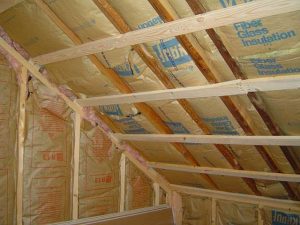Fiberglass Insulation Installation Tips to Ensure a Tightly Sealed Home
By Mark J. Donovan
|
|
When installing rolls of fiberglass insulation, or insulation batts, it is imperative to do it right to ensure a well insulated home or room. The necessary tools for installing fiberglass insulation are pretty basic. You’ll need a utility knife, a 2 or 4 foot wide straight edge, a measuring tape, a putty knife, and a staple gun and staples. Also make sure to dress in clothing from head to toe, and wear a mask and safety goggles.
Unfaced fiberglass insulation is easier to install, however after installing it you’ll need to cover the walls with a layer of plastic to create a vapor barrier. Unfaced fiberglass insulation does not require stapling. It depends upon friction to stay in place between the wall studs. |
If you decide to use faced fiberglass insulation, then you’ll need to staple the paper tabs to the inside edges of the wall studs to make sure you create a tight vapor barrier seal.
| Cutting Fiberglass Insulation Rolls and Batts
To install fiberglass insulation, first measure the height of a wall stud bay. Then, using your measuring tape, utility knife, and straight edge cut a piece of fiberglass insulation about 1 inch longer than your measurement. When cutting the fiberglass insulation, press the straight edge firmly down on it to compact it while you run your utility knife through it. If you are installing paper faced fiberglass insulation, cut it paper side down and take extra care not to tear or rip the paper when cutting it with your utility knife. |
 |
When installing fiberglass insulation in non-standard width bays, or narrow spaces, it works better to cut the pieces of insulation in place once you have installed them into the bay.
Installing Fiberglass Insulation
After cutting a piece of fiberglass insulation to length, push it all away into the back of the wall stud space and then pull its outer edges forward until its even with the outer edge of the wall studs. Make sure the insulation also goes all the way to the top and bottom of the stud bay. Also make sure there are no voids or gaps.
Make sure that you completely fill the spaces to prevent any voids. Leaving insulation voids around doors and windows is one of the main reasons for the drafts that are frequently found around them.
For help on building a home addition, see HomeAdditionPlus.com’s Home Addition Bid Sheets. Our Home Addition Bid Sheets provide you with the knowledge and information on how to plan a home addition project, and what to look for when hiring contractors. They also include detailed cost breakdown tables and spreadsheets for estimating your own new home addition building costs.
Related Information
- Learn What Type of Insulation R-Value Required for Each Part of the Home
- How to Insulate Interior Basement Walls
- How to Insulate a Crawl Space
Free Home Addition Price Quotes with No Obligation!
Fill out our 3-5 minute quick and easy form, and receive a free price quote on a house addition from one of our prescreened and licensed home addition contractors. This process is free and there is no obligation to continue once you receive your house addition price estimate.

